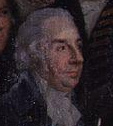John Pollexfen Bastard (18 September 1756 – 4 April 1816) was a British Tory politician, landowner and colonel of the East Devon Militia who was born and lived at Kitley House, Yealmpton, Devon.[1]
John Pollexfen Bastard | |
|---|---|
 | |
| Member of the Great Britain Parliament for Truro | |
| In office 1783–1784 Serving with Bamber Gascoyne | |
| Preceded by |
|
| Succeeded by |
|
| Member of the Great Britain Parliament for Member of Parliament for Devonshire | |
| In office 1784–1800 Serving with
| |
| Preceded by |
|
| Succeeded by | Self in Parliament of the United Kingdom |
| Member of Parliament for Devonshire | |
| In office 1801–1816 Serving with
| |
| Preceded by | Self in Parliament of Great Britain |
| Succeeded by |
|
| Personal details | |
| Born | 18 September 1756 |
| Died | 4 April 1816 (aged 59) |
| Political party | Tory |
| Relatives |
|
He married Sarah Wymondesold of East Lockinge, Berkshire, on 25 March 1780 at St Mary, Lambeth. She died in April 1808 leaving no surviving children. On 2 July 1809 he married, at Portland Chapel, Marylebone, Judith Anne Martin, daughter of Sir Henry Martin, naval commissioner at Portsmouth and Comptroller of the Navy. He left no children of either marriage.
Defence of Plymouth edit
When colonel of the East Devon Militia his father, William Bastard (b. 1 September 1727),[2] saved the arsenal of Plymouth from the French Fleet in August 1779 and, to recognise that, was gazetted a baronet on 4 September but he declined to assume the title.[3] Through his mother, born Bridget Poulett, William was a member of the Poulett, Bertie, Herbert and other influential families.
In 1801 when colonel of the same regiment John Pollexfen Bastard quelled a riot of workmen and prevented the destruction of the Plymouth docks and dockyards. In 1815 he was conveyed by the Royal Navy to Leghorn (Livorno) for his health where he died the next year and was initially buried in the Old English Cemetery in Livorno, where his monument still stands. His body was returned to Devon in a man-of-war.
Parliament edit
He was elected Member of Parliament for Truro in 1783 and for the Devonshire Constituency from 1784. He stood down in 1812 and was succeeded by his nephew Edmund Pollexfen Bastard (1784-1838) (the eldest son of his younger brother Edmund Bastard (1758–1816)), who held the seat until 1830.
According to the Oxford Companion to Children's Literature, Bastard indirectly inspired the familiar form of the children's rhyme "Old Mother Hubbard..." after instructing its author Sarah Catherine Martin, his sister-in-law, to "run away and write one of your stupid little rhymes."
Bastard owned several houses and large tracts of land in western England including his main residence Kitley House.
The National Portrait Gallery has a portrait of John Pollexfen Bastard standing beside his younger brother Edmund in a mezzotint of a painting by James Northcote.
He also can be spotted in Karl Anton Hickel's William Pitt addressing the House of Commons on the French Declaration of War, 1793 in the collection of the National Portrait Gallery.
A detailed account of his last journey and subsequent death can be found in the letters of Miss Eliza Simcoe, daughter of John Graves Simcoe, who travelled with John Pollexfen Bastard and his wife to Leghorn as part of her Grand Tour. She accompanied his wife on the rest of the journey and nursed her through several episodes of bad health. The letters are held at Devon Record Office as part of the Simcoe Family papers (REF:1038M).
Disambiguation edit
John Pollexfen Bastard—John Bastard RN and Edmund Pollexfen Bastard—Edmund Bastard
| Pollexfen Bastard | Bridget Poulett | ||||||||||||||||||||||||||||||||||||||
| William Bastard 1727–1782 | Anne Worsley | ||||||||||||||||||||||||||||||||||||||
| John Pollexfen Bastard 1756–1816 | Edmund Bastard 1758–1816 | Jane Pownoll | |||||||||||||||||||||||||||||||||||||
| Edmund Pollexfen Bastard 1784–1838 | John Bastard RN 1787–1835 | Rev Philemon Pownoll Bastard 1792–1846 | |||||||||||||||||||||||||||||||||||||
References edit
- ^ Parish register, Yealmpton, Devon, 19 September 1756
- ^ William Bastard. Devon, England, Church of England Baptisms, Marriages and Burials, 1538-1812. Accessed via ancestry.com paid subscription site, 17 September 2023.
- ^ *Bastard of Kitley, A Genealogical and Heraldic History of the Extinct and Dormant Baronetcies of England Ireland and Scotland, John Burke, Sir Bernard Burke, second edition, John Russell Smith, London 1844, page 44,
- Alastair W. Massie, ‘Bastard, John Pollexfen (1756–1816)’, Oxford Dictionary of National Biography, Oxford University Press, 2004; online edn, Jan 2009
- John Burke, ‘Bastard of Kitley’, A Genealogical and Heraldic History of the Commoners of Great Britain and Ireland. London: Henry Colburn, 1834
- Henri Bruno de Bastard d'Estang, Généalogie de la Maison de Bastard, originaire du comté nantais, existant encore en Guienne, au Maine, en Bretagne et en Devonshire, Paris: Imprimerie Schneider, 1847, p. 445
External links edit
- John Pollexfen Bastard's memorial at Livorno
- Devon Record Office mainpage
- Hutchinson, John (1902). . A catalogue of notable Middle Templars, with brief biographical notices (1 ed.). Canterbury: the Honourable Society of the Middle Temple. p. 14.